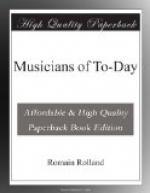It is not, however, Perosi’s dramatic genius that strikes me in his work; it is rather his peculiar mournfulness, which is indescribable, his gift of pure poetry, and the richness of his flowing melody. However deep the religious feeling in the music may be, the music itself is often stronger still, and breaks in upon the drama that it may express itself freely. Take, for instance, the fine symphonic passage that follows the arrival of Jesus and His friends at Martha and Mary’s house, after the death of their brother (p. 12 et seq. of Lazarus). It is true the orchestra expresses regrets and sighs, the excesses of sorrow mingled with words of consolation and faith, in a sort of languishing funeral march that is feminine and Christian in character. This, according to the composer, is a picture he has painted of the persons in the drama before he makes them speak. But, in spite of himself, the result is a flood of pure music, and his soul sings its own song of joy and sadness. Sometimes his spirit, in its naive and delicate charm, recalls that of Mozart; but his musical visions are always dominated and directed by a religious strength like that of Bach. Even the portions where the dramatic feeling is strongest are really little symphonies, such as the music that describes the miracle in The Transfiguration, and the illness of Lazarus. In the latter great depth of suffering is expressed; indeed, sadness could not have been carried farther even by Bach, and the same serenity of mind runs through its despair.
But what joy there is when these deeds of faith have been performed—when Jesus has cured the possessed man, or when Lazarus has opened his eyes to the light. The heart of the multitude overflows perhaps in rather childish thanksgiving; and at first it seemed to me expressed in a commonplace way. But did not the joy of all great artists so express itself?—the joy of Beethoven, Mozart, and Bach, who, when once they had thrown their cares aside, knew how to amuse themselves like the rest of the populace. And the simple phrase at the beginning soon assumes fuller proportions, the harmonies gain in richness, a glowing ardour fills the music, and a chorale blends with the dances in triumphant majesty.
All these works are radiant with a happy ease of expression. The Passion was finished in September, 1897, The Transfiguration in February, 1898. Lazarus in June, 1898, and The Resurrection of Christ in November, 1898. Such an output of work takes us back to eighteenth-century musicians.
But this is not the only resemblance between the young musician and his predecessors. Much of their soul has passed into his. His style is made up of all styles, and ranges from the Gregorian chant to the most modern modulations. All available materials are used in this work. This is an Italian characteristic. Gabriel d’Annunzio threw into his melting-pot the Renaissance, the Italian




